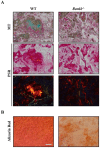3D Bone Biomimetic Scaffolds for Basic and Translational Studies with Mesenchymal Stem Cells
- PMID: 30322134
- PMCID: PMC6213614
- DOI: 10.3390/ijms19103150
3D Bone Biomimetic Scaffolds for Basic and Translational Studies with Mesenchymal Stem Cells
Abstract
Mesenchymal stem cells (MSCs) are recognized as an attractive tool owing to their self-renewal and differentiation capacity, and their ability to secrete bioactive molecules and to regulate the behavior of neighboring cells within different tissues. Accumulating evidence demonstrates that cells prefer three-dimensional (3D) to 2D culture conditions, at least because the former are closer to their natural environment. Thus, for in vitro studies and in vivo utilization, great effort is being dedicated to the optimization of MSC 3D culture systems in view of achieving the intended performance. This implies understanding cell⁻biomaterial interactions and manipulating the physicochemical characteristics of biomimetic scaffolds to elicit a specific cell behavior. In the bone field, biomimetic scaffolds can be used as 3D structures, where MSCs can be seeded, expanded, and then implanted in vivo for bone repair or bioactive molecules release. Actually, the union of MSCs and biomaterial has been greatly improving the field of tissue regeneration. Here, we will provide some examples of recent advances in basic as well as translational research about MSC-seeded scaffold systems. Overall, the proliferation of tools for a range of applications witnesses a fruitful collaboration among different branches of the scientific community.
Keywords: 3D culture; biomimetic scaffolds; mesenchymal stem cells; regenerative medicine; soluble factor release.
Conflict of interest statement
The authors declare no conflict of interest.
Figures


Similar articles
-
Comparative evaluation of morphology and osteogenic behavior of human Wharton's jelly mesenchymal stem cells on 2D culture plate and 3D biomimetic scaffold.J Cell Physiol. 2019 Dec;234(12):23123-23134. doi: 10.1002/jcp.28876. Epub 2019 May 24. J Cell Physiol. 2019. PMID: 31127624
-
In vitro design of mesenchymal to epithelial transition of prostate cancer metastasis using 3D nanoclay bone-mimetic scaffolds.J Tissue Eng Regen Med. 2018 Mar;12(3):727-737. doi: 10.1002/term.2492. Epub 2017 Oct 4. J Tissue Eng Regen Med. 2018. PMID: 28603879
-
Biomimetic macroporous PEG hydrogels as 3D scaffolds for the multiplication of human hematopoietic stem and progenitor cells.Biomaterials. 2014 Jan;35(3):929-40. doi: 10.1016/j.biomaterials.2013.10.038. Epub 2013 Oct 28. Biomaterials. 2014. PMID: 24176196
-
Recent Advances in Endocrine, Metabolic and Immune Disorders: Mesenchymal Stem Cells (MSCs) and Engineered Scaffolds.Endocr Metab Immune Disord Drug Targets. 2018;18(5):466-469. doi: 10.2174/1871530318666180423102905. Endocr Metab Immune Disord Drug Targets. 2018. PMID: 29692270 Review.
-
Biomimetic Materials and Fabrication Approaches for Bone Tissue Engineering.Adv Healthc Mater. 2017 Dec;6(23). doi: 10.1002/adhm.201700612. Epub 2017 Nov 24. Adv Healthc Mater. 2017. PMID: 29171714 Review.
Cited by
-
Mesenchymal Stem Cells and Tissue Bioengineering Applications in Sheep as Ideal Model.Stem Cells Int. 2024 Oct 18;2024:5176251. doi: 10.1155/2024/5176251. eCollection 2024. Stem Cells Int. 2024. PMID: 39465229 Free PMC article. Review.
-
Four-Dimensional Printing and Shape Memory Materials in Bone Tissue Engineering.Int J Mol Sci. 2023 Jan 3;24(1):814. doi: 10.3390/ijms24010814. Int J Mol Sci. 2023. PMID: 36614258 Free PMC article. Review.
-
Mesenchymal Stem/Stromal Cells and Their Paracrine Activity-Immunomodulation Mechanisms and How to Influence the Therapeutic Potential.Pharmaceutics. 2022 Feb 9;14(2):381. doi: 10.3390/pharmaceutics14020381. Pharmaceutics. 2022. PMID: 35214113 Free PMC article. Review.
-
Adipose-Derived Stem Cells in Bone Tissue Engineering: Useful Tools with New Applications.Stem Cells Int. 2019 Nov 6;2019:3673857. doi: 10.1155/2019/3673857. eCollection 2019. Stem Cells Int. 2019. PMID: 31781238 Free PMC article. Review.
-
Mesenchymal stem cells aligned and stretched in self-assembling peptide hydrogels.Heliyon. 2023 Dec 19;10(1):e23953. doi: 10.1016/j.heliyon.2023.e23953. eCollection 2024 Jan 15. Heliyon. 2023. PMID: 38234902 Free PMC article.
References
Publication types
MeSH terms
Grants and funding
LinkOut - more resources
Full Text Sources

